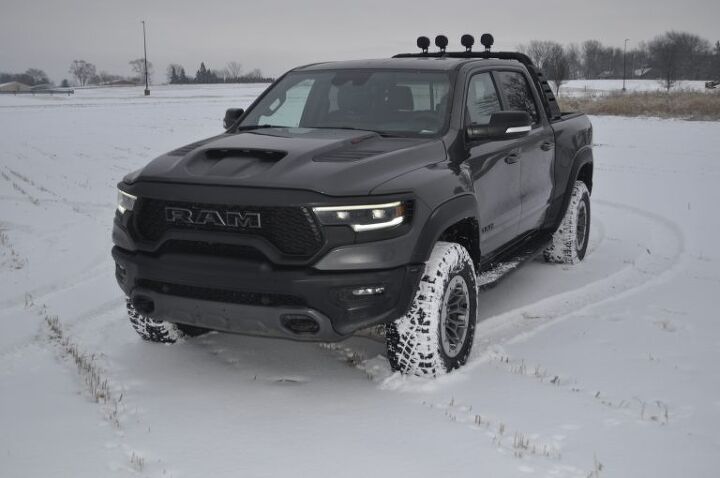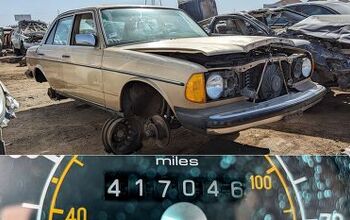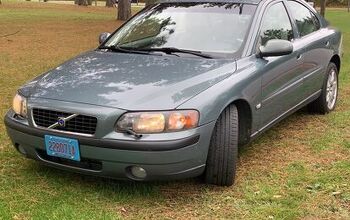2021 Ram 1500 TRX Review - You Don't Need It, But You'll Want It

2021 Ram 1500 TRX Crew Cab 4x4
When the 2021 Ram 1500 TRX launched last fall, the usual suspects on auto-journalist Twitter started complaining that the truck offered more power than anyone really needed, at a terrible cost to the environment, since a truck like this would suck down fuel at a distressing rate.
These folks had a point, though they seemed to ignore that the TRX is likely to sell in such small numbers that it’s unlikely these trucks will add much fuel to the climate-change fire.
Arguments about possible contribution to the destruction of our planet aside, there really is no logical reason to buy a TRX. You buy a 702-horsepower dune-jumper because you want one and can afford it. That’s pretty much it.
And you will want one, unless the acceleration leads you to need a change of pants, or if the Prius is too wild for you.
Those who want a truck that is focused on towing, or rides better on-road when unladen, or uses less fuel, will be better suited by other products in the Ram range. About the only thing the TRX does well other than perform – on and off pavement – is provide interior comfort. Well, the ride ain’t too shabby, considering the truck’s mission, though it’s not as smooth as your run-of-the-mill 1500.
“Hellcat all the things” is a running gag these days, and this truck is a runner, thanks to the 6.2-liter supercharged Hemi V8 that puts out the aforementioned 702 ponies and 650 lb-ft of torque. Passing is a cinch, and if you want to make yourself giggle and grin like an idiot, just find an open road, mash the gas, listen to the supercharger whine, and hold the eff on.
Speaking of holding on, I dutifully took the TRX off-roading on a muddy winter day. The truck was having no problems navigating the same trail that nearly swallowed a Raptor piloted by yours truly, and the Bilstein Black Hawk (2.6 inches front and rear) off-road shocks were mitigating the effects of the worst bumps and whoo-de-doos.
Then your humble author, in a moment of true dumbassery, nearly slid a $90K truck down an embankment, much to the consternation of his bemused father, who was riding shotgun.
At least the truck’s gauges can indicate the pitch angle when you’re worried that shifting wrong in your seat might send you a tumblin’.
Perhaps I am being unduly harsh on myself – I simply placed the wheels about a foot too far to the right and caught some mud, causing a slide toward no man’s land. I was trying to not go too far to the left and slam the truck into a berm and just overcompensated like a dude on Tinder.
Some friendly weekend warriors towed us out – not a quick or easy process – and the TRX soldiered on, undamaged. Shorts went unsoiled, but my ego took another bruise. If you’re keeping score, I am two-for-two on failures at that park when unsupervised (I made it around just fine in a Wrangler on a then-FCA-managed event some months after the Raptor incident).
As with my Raptor failure, I am left to wonder if the 35-inch Goodyear Wrangler all-terrain tires, meant to perform well off-road while still being livable on-road, aren’t as good in the deep muck as aftermarket rubber might be.
The truck managed just fine for the rest of the ride, even fording a creek without stressing me out. No bodywork was harmed, and the TRX ran like a champ on the ride back home. Also, if the manager of a certain coin-operated car wash in Chicago’s far western suburbs is reading this – sorry for ignoring your “no mud” sign and potentially clogging your drains. Thanks, though, for apparently not having security cameras.
On-road, the TRX, like its Raptor rival, rides well on the interstate. Well enough that you could easily daily this thing if you can afford the fuel costs. I never saw double-digit mpg numbers. The closest I came was 9.8. Yet thanks to a 33-gallon fuel tank, I still returned the truck to the fleet with a quarter tank remaining. Enough for those folks to get home with ease.
Perhaps the only dynamic flaw is that the steering, while well-weighted, feels a bit artificial at times. And the engine can be a bit loud even while loafing on the freeway. Then again, that’s probably to be expected.
Still, the TRX can handle an on-ramp with relative ease, though even a well-handling truck is still, well, a truck.
Besides the Bilsteins, other off-road goodies include a Dana 60 solid rear axle with a 3.55 ratio, full-floating hubs, and a damper for axle hop. The list further includes an electronic-locking rear differential, a heavy-duty air filter with dual filter elements, full-time active transfer case, five skid plates, 18-inch wheels, and mud/sand, rock, and Baja drive modes. You can check out off-road-specific gauges in the instrument cluster or via the infotainment screen, and a front camera helps with off-road obstacle navigation.
The suspension has active damping front and rear, forged aluminum front upper and lower control arms, and allows for wheel travel of over 13 inches at all four corners. It’s an independent suspension up front and a five-link coil design in the rear.
Ground clearance is listed at 11.8 inches. The non-off-road drive modes are auto, sport, tow, snow, and custom. I do not recall what drive mode I was in when I nearly rolled the ‘Rex. Other key off-road specs: The approach angle is 30.2 degrees, breakover is 21.9 degrees, and departure angle is 23.5.
On-road hijinks aren’t forgotten – this truck boasts launch control.
The TRX doesn’t come cheap, and not all the money the well-heeled truck nut spends goes towards the off-road stuff or the big motor. Standard features not already mentioned include high-performance brakes, full-speed forward-collision warning plus, Uconnect infotainment, navigation, 12-inch infotainment screen, leather flat-bottomed steering wheel, and shift paddles. The base price is a Starbucks latte short of $70K at $69,995.
Here comes the fun – it’s option time. There’s a lot, so for the sake of brevity I’ll skip a bit. It starts with the $200 Granite Crystal Metallic clear-coat paint. Next is the Technology Group ($1,095), which includes head-up display, LED third brake light, and auto-dimming rearview mirror. A Trailer Tow Group (trailer tire pressure monitoring and light check) adds $195. The Advanced Safety Group adds pedestrian/cyclist emergency braking, adaptive cruise control with stop and go, and lane-keep assist, for $995. The Bed Utility Group (bed step, tie downs, spray-in bedliner) adds $845. This truck’s paint was two-tone, so add $250 for that. A Carbon-Fiber Package changes the steering wheel to leather and carbon-fiber while keeping it flat-bottom and also adds red carbon-fiber interior accents. Add $1,295 for that.
Here comes the big one: The Level 2 Equipment Group. At $7,290, it includes leather-trimmed bucket seats, heated front seats, cooled front seats, heated second-row seats, heated steering wheel, full-length console, LED ambient lighting for the instrument panel, accent lighting for the front and rear doors, memory seat, power-adjustable pedals, trailer-brake control, blind-spot and cross-path detection, LED light for the pickup bed, front and rear parking assist, rain-sensing wipers, rear under-seat storage, keyless entry, remote start, power tailgate, and split-fold rear seat.
Rock rails add $995, premium audio from Harman Kardon another $1,195, and a bed-mounted spare-tire carrier yet another $995. Finally, we cap it off with $1,895 for upgraded aluminum wheels that remain 18 inches.
With $1,695 in D and D fees, our total is $89,565.
That’s a lot of money for a lot of truck – so much truck, that I couldn’t even park in my garage due to the light bar – but holy hell, it’s a lot of fun. Both on and off road.
And I didn’t even really get to jump it – I simply couldn’t find an adequate spot. Although there were some nice hops out of slimy mudholes. Unfortunately, those slimy mudholes weren’t home to small yet wise green creatures.
I can’t think of a use case for the TRX for anyone not named Ivan Stewart. Maybe that’s the point.
I mean, “hellacious fun” is a use-case, right?
[Images © 2021 Tim Healey/TTAC]

Tim Healey grew up around the auto-parts business and has always had a love for cars — his parents joke his first word was “‘Vette”. Despite this, he wanted to pursue a career in sports writing but he ended up falling semi-accidentally into the automotive-journalism industry, first at Consumer Guide Automotive and later at Web2Carz.com. He also worked as an industry analyst at Mintel Group and freelanced for About.com, CarFax, Vehix.com, High Gear Media, Torque News, FutureCar.com, Cars.com, among others, and of course Vertical Scope sites such as AutoGuide.com, Off-Road.com, and HybridCars.com. He’s an urbanite and as such, doesn’t need a daily driver, but if he had one, it would be compact, sporty, and have a manual transmission.
More by Tim Healey
Latest Car Reviews
Read moreLatest Product Reviews
Read moreRecent Comments
- 1995 SC If the necessary number of employees vote to unionize then yes, they should be unionized. That's how it works.
- Sobhuza Trooper That Dave Thomas fella sounds like the kind of twit who is oh-so-quick to tell us how easy and fun the bus is for any and all of your personal transportation needs. The time to get to and from the bus stop is never a concern. The time waiting for the bus is never a concern. The time waiting for a connection (if there is one) is never a concern. The weather is never a concern. Whatever you might be carrying or intend to purchase is never a concern. Nope, Boo Cars! Yeah Buses! Buses rule!Needless to say, these twits don't actual take the damn bus.
- MaintenanceCosts Nobody here seems to acknowledge that there are multiple use cases for cars.Some people spend all their time driving all over the country and need every mile and minute of time savings. ICE cars are better for them right now.Some people only drive locally and fly when they travel. For them, there's probably a range number that works, and they don't really need more. For the uses for which we use our EV, that would be around 150 miles. The other thing about a low range requirement is it can make 120V charging viable. If you don't drive more than an average of about 40 miles/day, you can probably get enough electrons through a wall outlet. We spent over two years charging our Bolt only through 120V, while our house was getting rebuilt, and never had an issue.Those are extremes. There are all sorts of use cases in between, which probably represent the majority of drivers. For some users, what's needed is more range. But I think for most users, what's needed is better charging. Retrofit apartment garages like Tim's with 240V outlets at every spot. Install more L3 chargers in supermarket parking lots and alongside gas stations. Make chargers that work like Tesla Superchargers as ubiquitous as gas stations, and EV charging will not be an issue for most users.
- MaintenanceCosts I don't have an opinion on whether any one plant unionizing is the right answer, but the employees sure need to have the right to organize. Unions or the credible threat of unionization are the only thing, history has proven, that can keep employers honest. Without it, we've seen over and over, the employers have complete power over the workers and feel free to exploit the workers however they see fit. (And don't tell me "oh, the workers can just leave" - in an oligopolistic industry, working conditions quickly converge, and there's not another employer right around the corner.)
- Kjhkjlhkjhkljh kljhjkhjklhkjh [h3]Wake me up when it is a 1989 635Csi with a M88/3[/h3]





































Comments
Join the conversation
Crappy pictures. Real crappy.
One of the better known car mags had a blast with a TRX on a paved track.